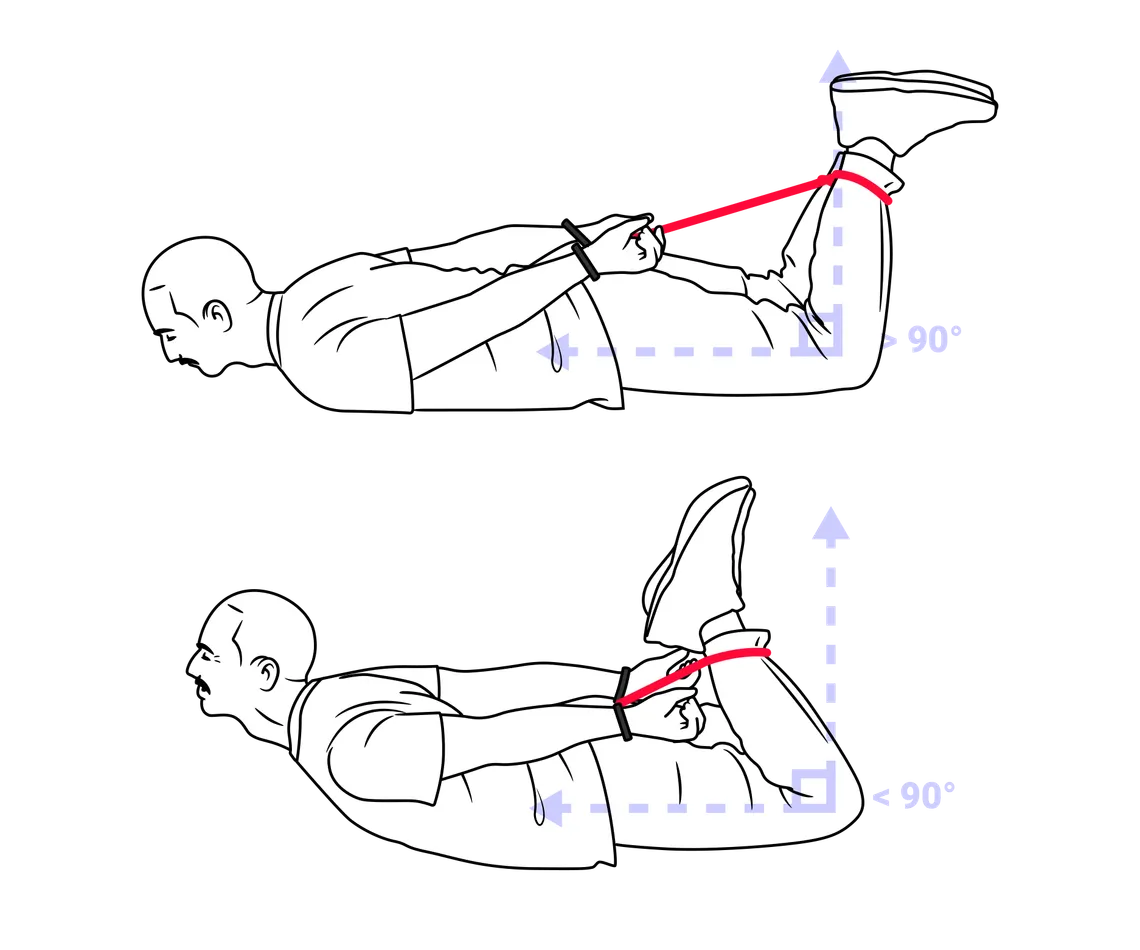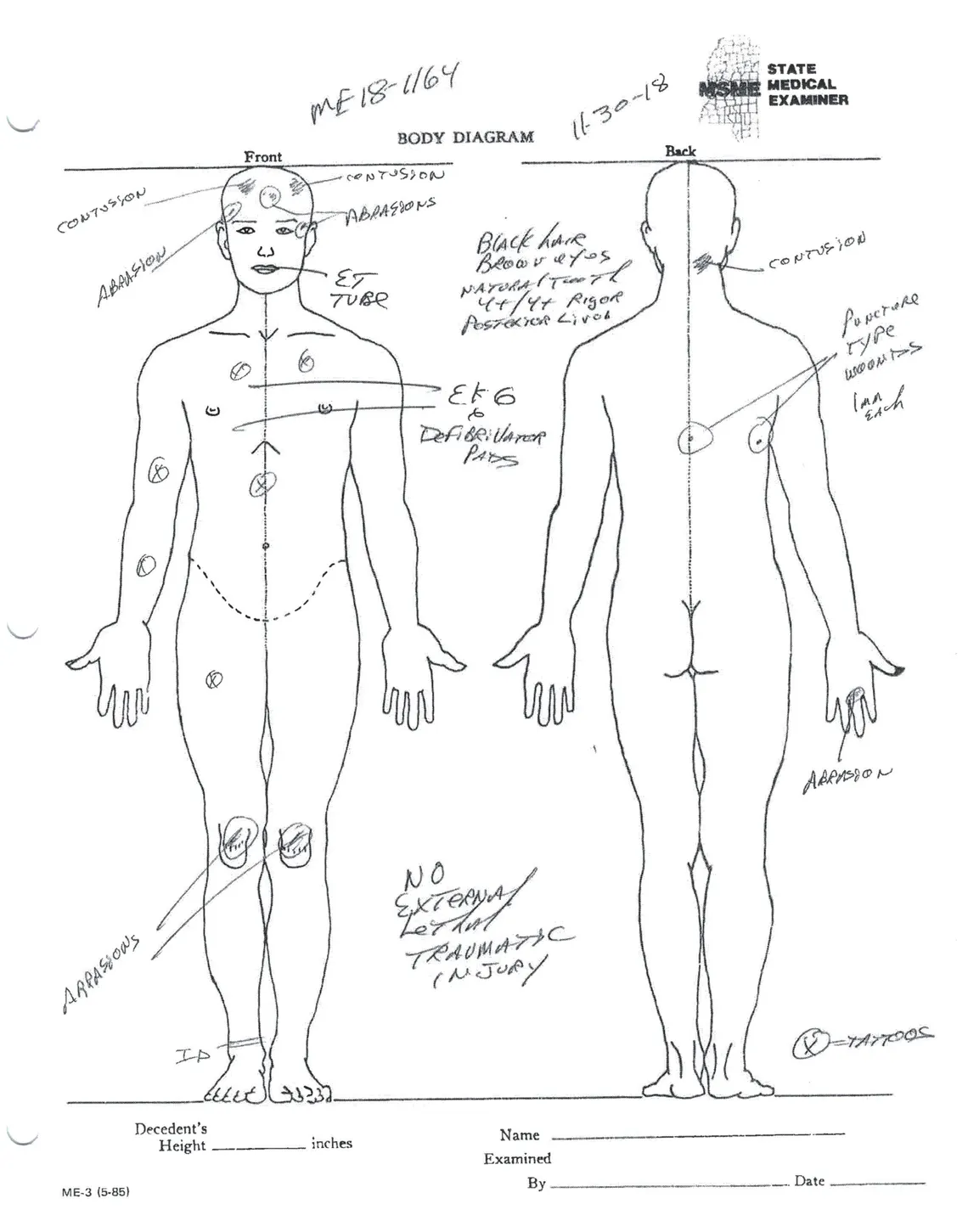GRENADA, Mississippi — Robert Loggins wandered into a neighbor’s backyard and fell down, crying for help. A woman dialed 911, telling the operator, “Please hurry!”
When police arrived at the home in this small town between Jackson and Memphis in November 2018, they found a Black man face down with his arms tucked beneath his body. One officer recognized Loggins, 26, who had battled both mental health and drug problems.
Officers repeatedly asked Loggins to put his hands behind his back, police video shows.
“Y’all going to kill me?” he asked.
“Nobody’s going to kill you,” a policeman reassured him.
In less than an hour, Loggins was dead, yet another fatality linked to police use of a dangerous restraint technique that the Justice Department condemned back in 1995. The agency, along with the International Chiefs of Police, warned law enforcement officials that keeping people restrained face down in what is known as the prone position increased the risk of death from asphyxia.
“As soon as the suspect is handcuffed, get him off his stomach,” the report urged. If that’s not possible, that person “should be closely and continuously monitored.”
The Justice Department also told officers never to use a hogtie — a form of prone restraint in which officers also attach wrists to ankles behind the person’s back. Many police departments have banned the practice because of its link to positional asphyxia.
But as the story of the Loggins family shows, actually persuading law enforcement to stop using hogties and prone-position restraints has proved almost impossible in small-town Mississippi.
At 5:45 a.m. on Sept. 17, 2005, deputies in Carroll County, a rural area southwest of Grenada, responded to a call about a fight and found Loggins’ mother, Debbie, grappling with another woman.
Debbie, 5-foot-4 and 220 pounds, had the woman in a headlock, Don Gray, the sheriff at the time, told reporters. When deputies tried to intervene, she became “verbally and physically combative,” he said, hitting one of the officers with his own flashlight.
Deputies initially placed her in handcuffs and leg shackles.
“It still was not enough,” Gray said. “They were trying to reduce the amount of her kicking. They had difficulty getting her into the car because she was putting her legs up and blocking them.”
That’s when deputies decided to hogtie her, binding her arms and legs together behind her back with an additional set of handcuffs, and placing her face down in the back seat of the squad car.
Deputies said that she “continued to squirm, kick and twist even after being hogtied,” according to a 5th U.S. Circuit Court of Appeals decision in a lawsuit filed by her estate, claiming police violated her constitutional rights.
During the trip to the jail, she became quiet and may have stopped breathing, but the deputy driving her didn’t realize that, the court said. When they arrived, the deputy went to get assistance from a jailer. They found she had no pulse. They began CPR and took her to a hospital, where she was pronounced dead at 7:37 a.m.
Authorities did not respond to requests for comment, but in court filings responding to the estate’s lawsuit, they have said that the officers did nothing wrong. A lawyer for Carroll County said in the filings that the death “had little to do with the actions of the officers,” and a federal judge dismissed the lawsuit filed by her estate, saying the restraints deputies used were reasonable.
Seth Stoughton, the co-author of the book “Evaluating Police Uses of Force” and an expert in law enforcement training, said officers erred in leaving her handcuffed in the prone position because of the danger of positional asphyxia, which occurs when a person is immobilized in a position that impairs breathing.
“You may need to put someone into that position while they’re being handcuffed or while leg restraints are being applied, but you don’t keep them in that position afterward,” he said. “You definitely don’t hold them or transport them in that position.”
Asked why hogtie deaths keep happening, Stoughton replied, “I wish I knew,” adding that the cases seldom draw administrative discipline, civil liability or criminal prosecution.
In Mississippi in 2015, four police officers in Southaven, on the Tennessee border, pinned Troy Goode down, handcuffed him and called for an ambulance. He died after being kept hogtied in the prone position for 90 minutes.
After the 5th U.S. Circuit Court of Appeals ruled that “hog-tying a drug-affected person in a state of drug-induced psychosis and placing him face down in a prone position for an extended period constitutes excessive force,” a lawsuit brought by Goode’s family was settled in July for an undisclosed amount.

A joint investigation by NBC News and The Marshall Project identified at least 23 deaths involving hogtying or similar restraints across the country since 2010. At least 13 of those who died had mental illnesses or were in mental crisis.
In the case of Debbie Loggins, the coroner’s chart suggested blood work should be done to rule out positional asphyxia, but no such test results are reflected in the autopsy report. The late pathologist who conducted the autopsy, Dr. Steven Hayne, made no mention of positional asphyxia in his findings.
Hayne ruled out trauma, drugs and alcohol, concluding that Loggins died because of advanced heat stroke, despite the fact the sun hadn’t risen when she was arrested, the weather temperature was in the 70s, and officers transported her in an air-conditioned car.
Instead, the pathologist — whose autopsies have been called into question — concluded her death was an accident, blaming her “excessive exertional activity.”
As a child, Robert Loggins loved to draw and write poetry, said his sister, Jessica Hayes.
His mother’s death when he was 13 years old devastated him, she said. “It gave him a different outlook on the world and the officers.”
That tragedy was compounded by the death of his grandmother, who helped raise him. He began to struggle in school, family members say.
He experienced mental and behavioral problems, receiving psychiatric treatment. Marijuana and meth became an unfortunate escape for Loggins, said his father, Robert Ford.
Loggins began committing burglaries and other crimes to fund his habit. He was 17 when he was arrested in 2010 for stealing four tires and wheels from a Toyota Camry. The judge sentenced him to 10 years in prison.
In 2015, the parole board gave Loggins a second chance.
He married, and he and his wife had a son. He earned his GED, worked a couple of jobs and began putting himself through community college, where he began to learn welding, his father said. He also won some local renown, writing and recording his own rap music.
But drugs reentered his life, his father said. He struggled to break the habit, enrolling in two different rehabilitation centers.
In 2018, Ford visited his son in the Grenada County Jail; Loggins had been arrested for violating parole.
“It’s kind of hard to talk about, but he was calling me, ‘Dad,’ and he was crying,” Ford recalled. “I told him, ‘Son, it’s going to be all right.’”
When Loggins was freed several months later, Ford picked him up, and all Loggins could talk about was seeing his son in Oxford, about 50 miles north. Ford said he would be happy to drive him there at the end of the workweek.
For Loggins, the weekend never came.
The 911 call in the early morning hours of Nov. 29, 2018, recorded a neighbor saying, “Someone’s in the back of my house calling for help.”
Five members of the Grenada Police Department responded, some of whom had known Loggins since he was young.
In bodycam footage obtained by the Mississippi Center for Investigative Reporting and The Marshall Project, officers repeatedly asked Loggins to put his hands behind his back.
“My soul belongs to Jesus Christ,” he told them.
“Take your hands from up under you,” one officer barked.
“He’s my savior!” Loggins said.
“Your ass belongs to us now,” an officer replied.
When Loggins didn’t put his hands behind his back, police used a Taser eight times, according to Grenada police records. (Taser’s manufacturer warns that repeated blasts increase the risk of a heart attack.)
“Give me a baton, give me a baton,” one officer said.
Officers then grabbed Loggins. Albert Deane Tilley, who had worked in the department for little more than a year, in his first job in law enforcement, said Loggins bit him on the hand. Bodycam footage showed officers striking Loggins with a flashlight.
After handcuffing the 5-foot-8, 190-pound man, officers carried him to a carport, where a report by the Mississippi Bureau of Investigation claims “Loggins’ disorderly behavior” kept emergency personnel from conducting “a full medical assessment.”
But bodycam footage paints a different picture. As officers carry Loggins, an EMT can be heard saying, “He looks fine to me.”
Jail video shows that at 5:59 a.m., officers carried Loggins upside down into the lobby of the jail. They left him on the floor, handcuffed and in the prone position.
He seemed in distress, rolling from side to side, shift supervisor Sgt. Edna Clark told the investigations bureau. “To me, he was trying to gasp for breath because he couldn’t breathe.”
She said she asked officers to take Loggins to the hospital but was waved off.
After Tilley reportedly told the jailers that he needed his handcuffs back, at least four officers and jailers piled on top of Loggins at 6:04 a.m. to remove the cuffs from his wrists, video shows. When the officers got off Loggins more than three minutes later, he didn’t move.
Clark noticed he was bleeding and called 911. The dispatcher replied that EMTs had previously checked him.
“He’s bleeding from his mouth. He’s bleeding from his legs,” she told the dispatcher. “I’m not gonna take him.”
At 6:14 a.m., Clark checked Loggins’ pulse and his breathing. She called 911 again.
“This man has got no heartbeat, and he’s not breathing. I want them officers back over here. I want an ambulance,” she said. “Get them over here now.”
A few minutes later, medical personnel arrived. They pounded on Loggins’ chest in hopes of reviving him, and when they couldn’t, they airlifted him to a hospital, where he was pronounced dead. He was 26 — seven years younger than his mother when she died.
Five officers were placed on administrative leave with pay, but there were no criminal charges and no known disciplinary action. The investigations bureau interviewed the officers, who denied any wrongdoing as part of the probe.
Tilley told the bureau’s investigator, Mark Steed, that when the police first encountered Loggins, he was saying things that didn’t make sense, which made him believe Loggins was under the influence.
Tilley and Steed sparred about whether Loggins was hit with a flashlight, according to the transcript in the bureau’s report. At first, Tilley denied using his flashlight to strike Loggins and said no one else did either.
After being pressed to tell the truth, Tilley conceded he had seen Loggins being hit — in the elbow.
Tilley denied seeing any broken teeth, but photographs of Loggins after his death show his teeth were indeed broken.
Asked if he put his knee on Loggins’ neck or head at the jail, Tilley replied, “Not to my recollection, no, sir. I don’t believe it was.”
In the video, Tilley can be seen kneeling on Loggins, although it’s not entirely clear if the deputy is kneeling on his neck or upper back. Later, the officer can be seen sitting on Loggins. Tilley’s attorney would not comment on the matter.
“What these officers seem to be saying is this man’s ability to breathe was less important to them than a pair of handcuffs,” said the lawyer for Loggins’ estate, Jacob Jordan.
On Dec. 31, 2020, Loggins’ wife, Rika Jones, filed a lawsuit in U.S. District Court, accusing the officers of assault and the medical personnel and private jail operator of failing to provide him proper medical treatment.
In responding to the suit, Tilley’s lawyer wrote that there is no proof the officer caused Loggins’ death or acted with excessive force, and that he is shielded by qualified immunity, a legal doctrine that says government workers can’t be held liable for what they do on the job, except in rare circumstances.
Other officers also deny any wrongdoing. They are asking the judge to throw out the lawsuit, saying they are immune from such litigation because Loggins’ constitutional rights were never violated.
“Loggins repeatedly failed to follow commands, would not display his hands, and even assaulted an officer,” they wrote in court filings. “The video shows only the use of force necessary to effectuate the arrest.”
In its response, the private jail operator, Corrections Management Services, says that its staff acted in good faith, with Sgt. Clark advising police “multiple times that Loggins would not be accepted into the jail and that he needed medical attention.” Medical personnel have denied the suit’s allegations of failure to provide proper treatment.
The state medical examiner ruled Loggins’ death an accident, just like his mother’s.
The alleged culprit? Methamphetamine toxicity.
The chief medical examiner who conducted the autopsy, Dr. Mark LeVaughn, was placed on administrative leave last November as the result of an unspecified attorney general’s investigation. In January, he resigned. He could not be reached for comment.
The autopsy makes no reference to the jailhouse video, which isn’t contained in the case file.

After viewing the video as well as the autopsy report and photos at the request of the Mississippi Center for Investigative Reporting, forensic pathologist Dr. Michael Baden concluded Loggins’ death was a homicide, saying the methamphetamine was not a fatal amount.
“They killed him by piling on top of him,” he said. “He absolutely died from some kind of asphyxia.”
After MCIR’s story on Loggins’ death appeared in April, with the video included, U.S. Rep. Bennie Thompson and other Mississippi leaders asked U.S. Attorney General Merrick Garland to have the Justice Department investigate. Loggins’ father said the FBI has interviewed him. (The FBI declined to comment.)
This summer, Ford stood with other protesters outside the Grenada County Jail, calling for justice in his son’s case. If officers had taken Loggins into a cell to remove his handcuffs instead of piling on top of him while he was face down, “he would be alive today,” his dad said. “He didn’t deserve to die like that.”
